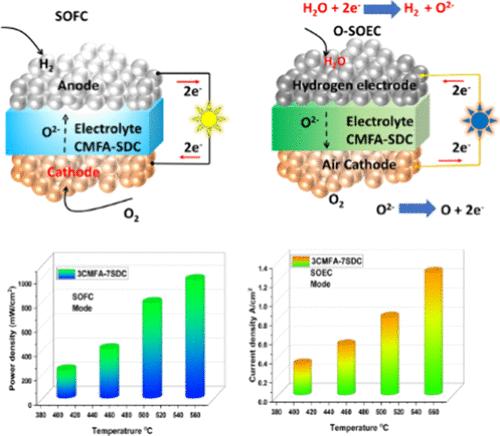混合导电 Co0.6Mn0.4Al1.6Fe0.4O4-Sm0.2Ce0.8O2 异质结构复合电解质膜在 SOFC 和 SOEC 模式下的性能评估
IF 5.4
3区 材料科学
Q2 CHEMISTRY, PHYSICAL
引用次数: 0
摘要
离子导电性和电荷传输能力的显著提高,再加上低工作温度下的低活化能,将大大促进低温固体氧化物电解(450-550 °C)的广泛应用。为此,我们设计了一种由 Co0.6Mn0.4Fe0.4Al1.6O4 (CMFA)和 Sm0.2Ce0.8O2 (SDC)的棘状结构组成的复合半导体异质结构粉末,可作为 SOFC(固体氧化物燃料电池)和 SOEC(固体氧化物电解电池)的有效电解质膜。这种复合异质结构旨在提高燃料电池和电解性能,尤其是在低工作温度下的性能。所设计的 CMFA-SDC 异质结构可用作 SOFC 和 SOEC 的电解质,NCAL 可用作电极。在 SOEC 模式下,复合异质结构可在 550 ℃、1.6 V 的恒定电压下提供 1.32 A/cm2 的高电流密度。此外,在燃料电池模式下,复合电解质在 550 °C 时的峰值功率密度(PPD)为 980 mW/cm2。这种利用锂化合物作为电极的燃料和电解电池具有优异的功率密度和制氢能力,有望成为氧化物离子传导型低温 SOFC 和 SOEC。研究人员利用多种透射和光谱方法,包括可见光范围内的 X 射线衍射和光电子能谱,研究了 CMFA-SDC 异质结构复合材料增强离子传导的性能。此外,还详细介绍了基于异质结和内置电场的传导机制。这些研究结果表明,对于 LT-SOEC 而言,异质结构方法是实用的。本文章由计算机程序翻译,如有差异,请以英文原文为准。

Performance Evaluation of the Mixed Conducting Co0.6Mn0.4Al1.6Fe0.4O4-Sm0.2Ce0.8O2 Heterostructure Composite Electrolyte Membrane in SOFC and SOEC Mode
A significant improvement in ionic conductivity and charge transportation, coupled with a low activation energy at low operating temperatures, would significantly enhance the widespread application of low-temperature solid oxide electrolysis (450–550 °C). Following this, here we designed an intriguing composite semiconductor heterostructure powder composed of a spine-like structure of Co0.6Mn0.4Fe0.4Al1.6O4 (CMFA) and Sm0.2Ce0.8O2 (SDC) that serves as an effective electrolyte membrane for SOFCs (solid oxide fuel cells) and SOECs (solid oxide electrolysis cells). The composite heterostructure is designed to enhance the fuel cell and electrolysis performance, especially at low operational temperatures. The designed CMFA-SDC heterostructure functions as an electrolyte and NCAL functions as electrodes for SOFC and SOEC. In SOEC mode, the composite heterostructure delivers a high current density of 1.32 A/cm2 with an applied constant voltage of 1.6 V at 550 °C. Besides, in fuel cell mode, the composite electrolyte delivers a peak power density (PPD) of 980 mW/cm2 at 550 °C. This fuel and electrolysis cell, which utilizes lithium compounds as electrodes, has great promise as oxide ion conductive low-temperature SOFC and SOEC, as demonstrated by its exceptional power density and hydrogen production capability. The CMFA-SDC heterostructure composite’s increased ionic conduction was studied by utilizing a variety of transmission and spectroscopic methods, including X-ray diffraction and photoelectron spectroscopy in the visible range. Moreover, the conduction mechanism based on the heterojunction and built-in electric field has been presented in detail. These findings suggest that the heterostructure approach is practical for the LT-SOECs.
求助全文
通过发布文献求助,成功后即可免费获取论文全文。
去求助
来源期刊

ACS Applied Energy Materials
Materials Science-Materials Chemistry
CiteScore
10.30
自引率
6.20%
发文量
1368
期刊介绍:
ACS Applied Energy Materials is an interdisciplinary journal publishing original research covering all aspects of materials, engineering, chemistry, physics and biology relevant to energy conversion and storage. The journal is devoted to reports of new and original experimental and theoretical research of an applied nature that integrate knowledge in the areas of materials, engineering, physics, bioscience, and chemistry into important energy applications.
 求助内容:
求助内容: 应助结果提醒方式:
应助结果提醒方式:


